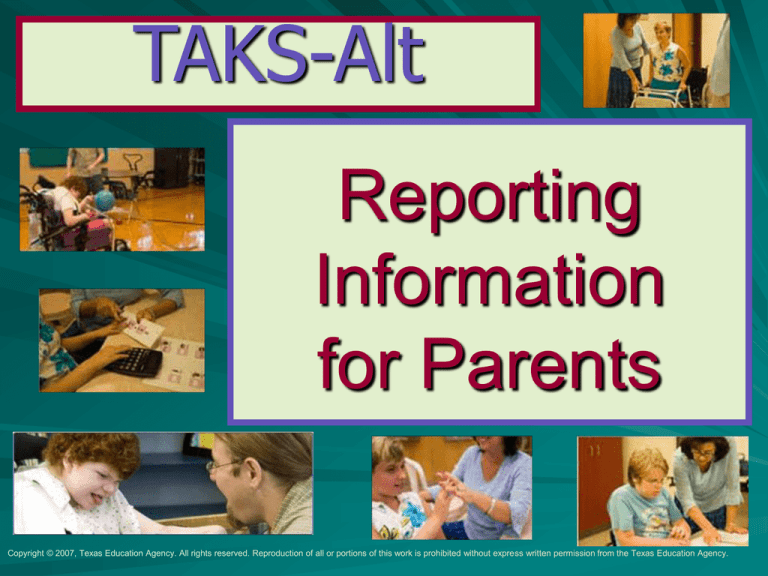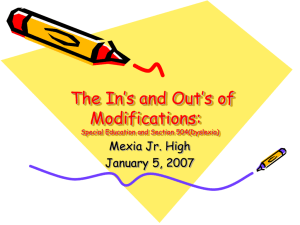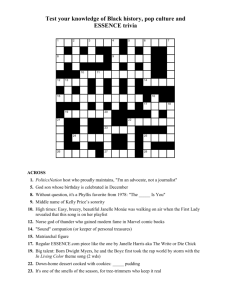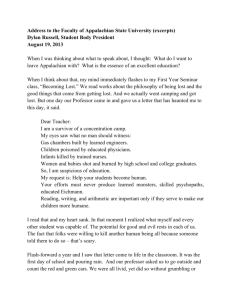
TAKS-Alt
Reporting
Information
for Parents
Copyright © 2007, Texas Education Agency. All rights reserved. Reproduction of all or portions of this work is prohibited without express written permission from the Texas Education Agency.
What is the Texas Assessment of
Knowledge and Skills – Alternate
(TAKS-Alt)?
An alternate assessment to TAKS for students
with significant cognitive disabilities
An assessment based on the TEKS curriculum
that is linked to grade-level student expectations
through prerequisite skills
An observation of student performance on
teacher-created instructional activities – not a
traditional paper-and-pencil test
TAKS-Alt is available for:
Mathematics for Students Enrolled in Grades
3-11
Reading for Students Enrolled in Grades 3-9
Writing for Students Enrolled in Grades 4 and 7
English Language Arts (ELA) for Students
Enrolled in Grade 10 and 11
Science for Students Enrolled in Grades 5, 8,
10, and 11
Social Studies for Students Enrolled in Grades
8, 10, and 11
Why TAKS-Alt?
Federally mandated by the
Individuals with Disabilities Education Act (IDEA)
and
No Child Left Behind Act of 2001 (NCLB)
ALL students must have access to grade-level curriculum;
in Texas this is the Texas Essential Knowledge and Skills
(TEKS) curriculum.
ALL students served by special education must be included
in the state assessment program, with appropriate
accommodations; in Texas this is the Texas Assessment of
Knowledge and Skills (TAKS) – of which TAKS-Alt is a part.
As required by federal law –
ALL means ALL
There are
NO
exemptions!
What’s the difference between
TAKS and TEKS?
TAKS = assessment
TEKS = curriculum
All TAKS tests, including TAKS-Alt, are
divided into test objectives.
Objectives are “umbrella statements” that
serve as headings under which the TEKS
knowledge and skills statements and
student expectations are grouped.
Here’s an example from
3rd grade reading:
TAKS Objective 1: The student will demonstrate a basic
understanding of culturally diverse written texts.
This is what is tested on
TAKS as well as TAKS-Alt.
TEKS Knowledge and Skills Statement (3.5)
Reading/word identification. The student uses a variety
of word identification strategies. The student is expected to
(D)
use root words and other structural cues such as prefixes, suffixes, and
derivational endings to recognize words; and
is specifically
(E) use knowledge of word order (syntax)This
and context
to supportwhat
wordis
identification and confirm word meaning. taught from the curriculum and
what your child is required by
law to have access to.
TAKS-Alt summarizes the Knowledge
and Skills Statement and student
expectations into an essence
statement.
Your child will either directly
access the essence statement
through grade-level student
expectations
A student should either OR
access the curriculum
through a prerequisite skill.
If your child is able to directly access one of the
grade-level student expectations such as the
ones in the box below, then. . .
no prerequisite skill is chosen and
the following is recorded in the
prerequisite field:
The teacher will then
create an activity to
address the essence
statement.
N/A The student will directly
access the essence statement
through grade-level student
expectations.
Students taking TAKS-Alt will most likely need
to access the curriculum through a prerequisite
skill. If so, then the teacher will. . .
target an appropriate prerequisite
skill and develop an activity to
address it. The prerequisite skill
will be recorded in the prerequisite
field.
So,
So,what
whatdoes
doesaaTAKS-Alt
TAKS-Alt
activity
look like?
activity
look like?
NOTE:
Activities should include ALL
needed supports.
Activities should include all needed
supports
What are predetermined criteria?
Academic behaviors that the teacher will
observe during an activity to determine
whether your child is successful
Must be 3 per instructional activity
Must be observable and measurable
Must be developed prior to the observation
Predetermined Criteria
These are the observable actions
Sam must perform in the
previous activity.
These make the actions
measurable.
How is TAKS-Alt scored?
Teachers record observation notes
about the student’s performance on
the predetermined criteria
THEN
score student performance using
the TAKS-Alt rubric.
TAKS-Alt Rubric
Demonstration of Skill is one dimension on
the rubric. Your child will be scored from
1
to 3 based on the number of predetermined
criteria completed.
Level of Support is another dimension on the
rubric. Your child will be scored from 1 to 3 based
on the type of additional support needed to
complete the predetermined criteria.
Generalization of Skill
Generalization is an additional dimension of the rubric.
If your child earns a score with any combination of
Demonstrated and/or Developing, then a generalization
opportunity must be provided.
Generalization of Skill
Must occur in a different context such as in
a new location, with a different person, or
with different materials
Must be observed for at least one of the
predetermined criteria
Must be performed at the same level as in
the primary observation
Must be at or above the same level of
support
Generalization of Skill
Teachers document
successful generalization
and give the student an
additional score point on the
activity.
How long does
the assessment take?
TAKS-Alt began on Oct. 1 and ends on
April 18.
Your child is required to complete 6
essence statements (or instructional
activities) per grade and subject.
Your child should not even know he or she
is being assessed.
How will I know how my child
performed on TAKS-Alt?
Parents will receive Confidential Student
Reports (CSRs) in May after the
assessment has been finalized.
By examining your child’s CSR, you will
find the score the teacher gave your child
on each instructional activity in each
tested subject area, as well as a total
score for each subject area tested.
TAKS-Alt Performance Categories
There are 3 student performance categories:
Commended Performance (39 out of a
possible 42 points per subject area)
Met Standard (24 out of a possible 42
points)
Did Not Meet Standard (less than 24
points out of a possible 42)
Commended Performance
This category represents strong academic
achievement. Students in this category
performed with success at a mostly independent
level that was considerably above the state
passing standard. Students were able to
generalize a number of skills in a different
context. Students demonstrated consistent
understanding of the knowledge and skills that
are linked to content measured at this grade.
Met Standard
This category represents satisfactory academic
achievement. Students in this category
performed with moderate success at a level that
was at or somewhat above the state passing
standard and may have required some
additional cueing and prompting. Students may
have generalized skills in a different context.
Students demonstrated a sufficient
understanding of the knowledge and skills that
are linked to content measured at this grade.
Did Not Meet Standard
This category represents emerging
academic achievement. Students in this
category performed with limited success at
a level that was below the state passing
standard and most likely required cueing
and prompting. Students demonstrated a
beginning understanding of the knowledge
and skills that are linked to content
measured at this grade.
Confidential Student Report
Test Objectives
Student
Identification
Information
Subjects
Student Results
Confidential Student Report
Six essence statements are required
per subject. Some objectives will
have two essence statements
assessed to reach the total of six.
The total score on all objectives/essence
statements per subject determines the
performance category.
Confidential Student Report
If a + is recorded in
place of a numeral in
any of the score slots, it
indicates that the
essence statement was
not assessed.
The student will receive a partial score when less than 6
essence statements are assessed. A partial response may
occur when a student moves into the district without enough
time to complete the assessment or when a student has a
medical condition or emergency that results in an incomplete
assessment.
Confidential Student Report
A student may receive a “No Response Observed” score
if unable to display any observable or purposeful change
in affect or movement due to an ongoing medical
condition or the severity of the student’s disability.
What is the role of the ARD
committee in assessment
decisions?
To decide if your child meets the participation
requirements for the recommended assessment
To determine which assessment from the state
options is the best for your child
To review the state-required essence statements
and give input into the teacher-selected essence
statements if TAKS-Alt is selected
TAKS-Alt Contacts
and Additional Information
For additional information regarding TAKS-Alt, including materials and
PowerPoint presentations on:
Fall 2007 ESC TAKS-Alt Training
Writing Predetermined Criteria
Accurate scoring
refer to the TEA TAKS-Alt website at
http://tea.state.tx.us/student.assessment/resources/taksalt
To review the TAKS-Alt Training Modules, ask your school for password
information, then refer to https://pearson.learn.com
To contact a member of the TAKS-Alt team at TEA for additional questions:
Phone: (512) 463-9536 (Pat Otto, Debbie Owens, Janet Borel)
E-mail : Assessments.StudentswithDisabilities@tea.state.tx.us






